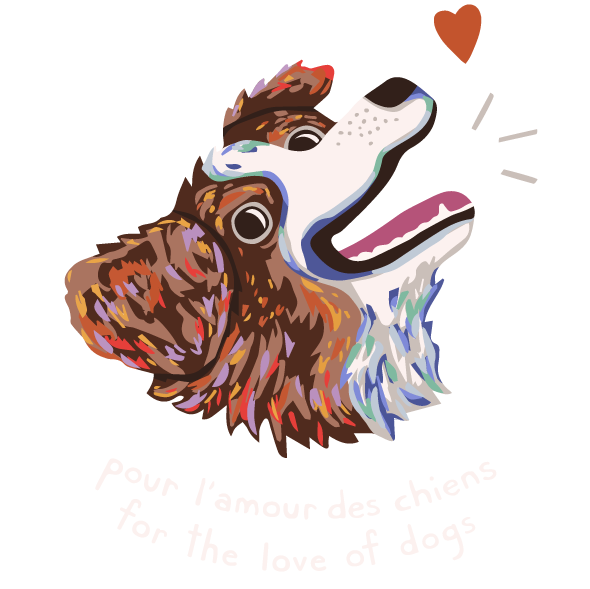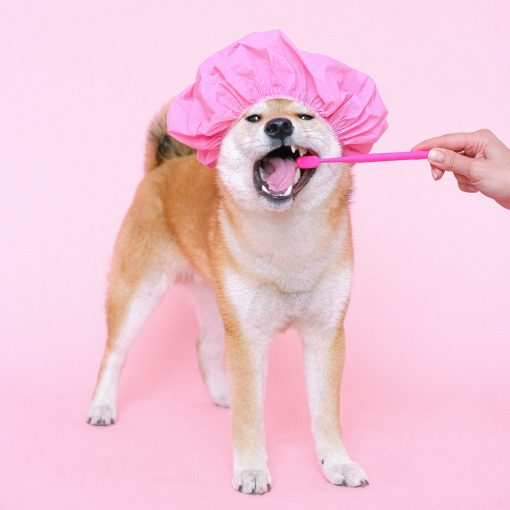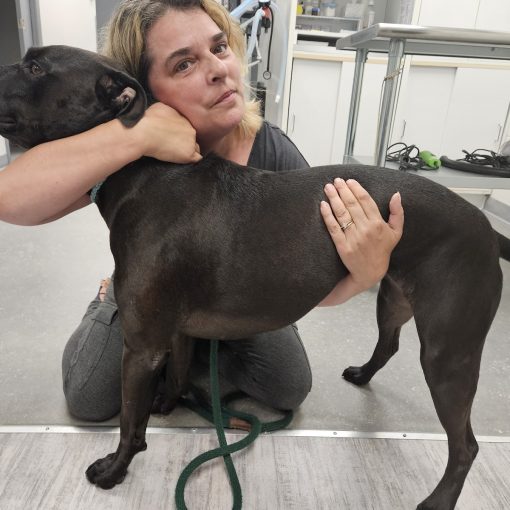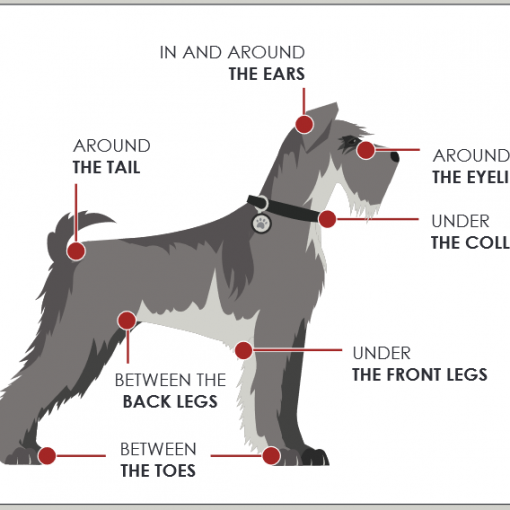It’s a good idea to train things you don’t know that you need, before you may need them.
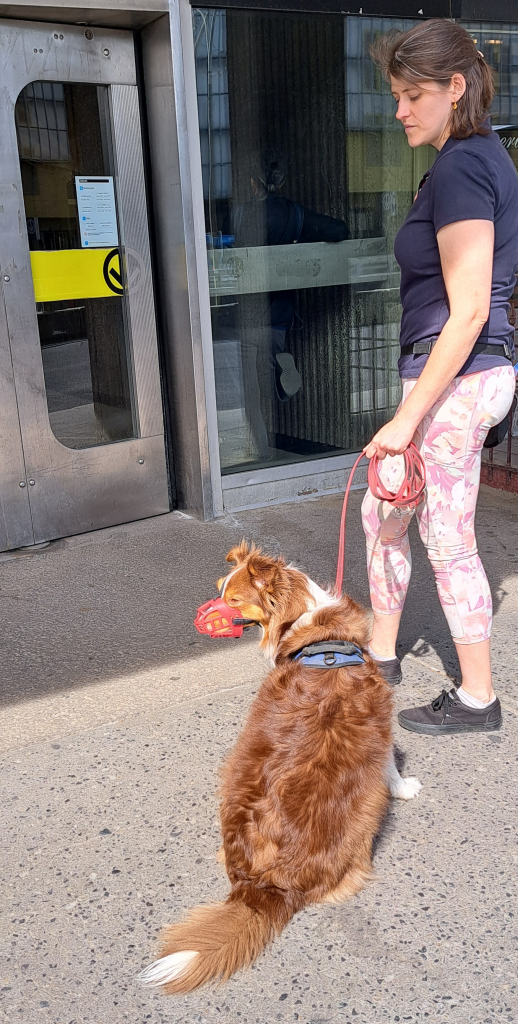
Mia being stylish waiting to go into the metro.
Muzzles get a bad rap. We think only scary, aggressive dogs wear them when this just isn’t true. Dogs that wear a muzzle in public, do so most often because they’re scared. People use this with other training as a safety measure along with other training and tools (like a leash!). The muzzle is there in case training and other tools fail. Often my clients with dogs who wear muzzles in public spaces feel that if people in general were more respectful, their dog wouldn’t have to wear a muzzle at all, and they’re right. The muzzle is there in case someone lowers a hand and strokes their dog without asking while the owner’s head is turned (please never do this); or in case an off leash dog comes directly into their dog’s space. So in fact dogs wear muzzles to protect people and other dogs, but mostly to protect themselves from people who put them in inappropriate situations.
There are MANY other reasons dogs wear muzzles: they eat poop (remember, dogs are coprophagous, yum!) , they pick up anything and everything outside with their mouth and will swallow it, they’re scared of other dogs, in order to go into the Montreal metro, they’re scared at the vet, they’re scared at the groomer.
By and large, we use them often when we have to physically handle a dog. Basically animals and constraint don’t really go together. We need to teach them (slowly) that the procedure that needs to be done that requires the muzzle, will not actually kill them. It’s also a really very good idea to teach them how to wear the muzzle, so that this does not add to their stress. I will tell you, I have seen precious few dogs who didn’t react negatively to having a muzzle simply put on their face. The majority of my clients get to me when their dog is already hiding behind the couch at the sight of their muzzle. If you want to help lower your dog’s level of stress, at an already very stressful situation for them, or if you want to reduce your carbon footprint and bring Fluffy along for a metro ride; here’s how to make it positive, fun and delicious for your dog:
Pro tip: Take small steps
Step 1: Positive association
- Show Your dog the muzzle, MARK your behaviour, say YES! And reward.
- Present the muzzle in all sorts of different ways, left side, right side, between your open legs, a little higher or lower in the air, be creative!
Step 2: Have your dog take treats with their face inside the muzzle
- Take a very long treat so your dog can easily take it from inside the muzzle (you’ll need to feed them through the muzzle, so their face is inside but not with the straps attached yet).
- Give them the treat through the muzzle.
*VERY IMPORTANT: Be sure to keep the muzzle away from your dog’s face, don’t let them pull their face out of the muzzle themselves. Otherwise, the dog will get into the habit of putting their face in and pulling it out again.
- Once they can do this, feed them and start backing up so they have to press their face into the muzzle to get the treat out.
Step 3: Increasing the time your dog’s head is inside so we can play with the straps (duration).
- Get lots of pieces of treats
- Feed them piece by piece, progressing from 3 to 5, then 8 and 10.
- Make sure you remove the muzzle after the 3,5,8 and 10 treats so they don’t take their own head out
What you are looking for: That hey can eat each treat without taking their head out of the muzzle
Step 4: The Straps
- Start playing with the straps while your dog is eating the treats you give them one by one.
What you are looking for: They can eat for 5 seconds while you play with the straps.
Step 4.5: More duration with your dog’s face inside the muzzle while you play with the straps.
- Get lots of pieces of treats.
- As you feed them one at a time, start putting more and more time between each piece, so that your dog is really waiting for each piece without removing their head. This step is more difficult than it sounds. If they take their head out, you are feeding too slowly. Think that you are moving from continuous feeding to intermittent feeding.
What you are looking for: That they can eat only 3-5 treats for a full 10 seconds while one of you is feeding and the other plays/holds the straps on their head (light pressure).
Step 5:
- Attach the straps, release your hands, then go back and remove them again.
What you are looking for: They can eat for 5 seconds with the straps attached.
Step 6: With the straps attached, we ask for commands
- Feed your dog one treat at a time while the straps are attached.
- Once strapped in, start asking for behaviours: down, sit, touch, paw, etc.
- Reward each one
What you are looking for: That your dog can do what you ask, maybe a little in slow motion, but they are quite capable.
Step 7:
- Put on your dog’s leash
- Put on the muzzle and fasten the straps (with as many pieces of food as you want for now)
- Walk two steps, reward, ask for behaviour, reward
- Remove muzzle
What you are looking for: they can walk around and easily give you the commands you ask for.
Step 7.5: Add more steps! Walk around the house! Ask for more behaviours!
Step 8: Start going outside for short periods of time, put the muzzle on, walk around and then take it off. Slowly increase the time the muzzle is on their face.
There are variations of this training where you teach the dog a “stay” in many positions, and then you get them to “stay” with their face inside the muzzle. Remember, the steps may be simple, but it’s not easy! Here are two videos to help you put a visual to the text:
Part 1 https://www.facebook.com/reel/961520678447078
Part 2 https://www.facebook.com/reel/660483442807290
Don’t hesitate to contact us for some help.
Happy training!
Riannon
Owner/Trainer
Pour l’Amour des Chiens/For the Love of Dogs
